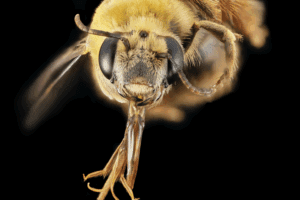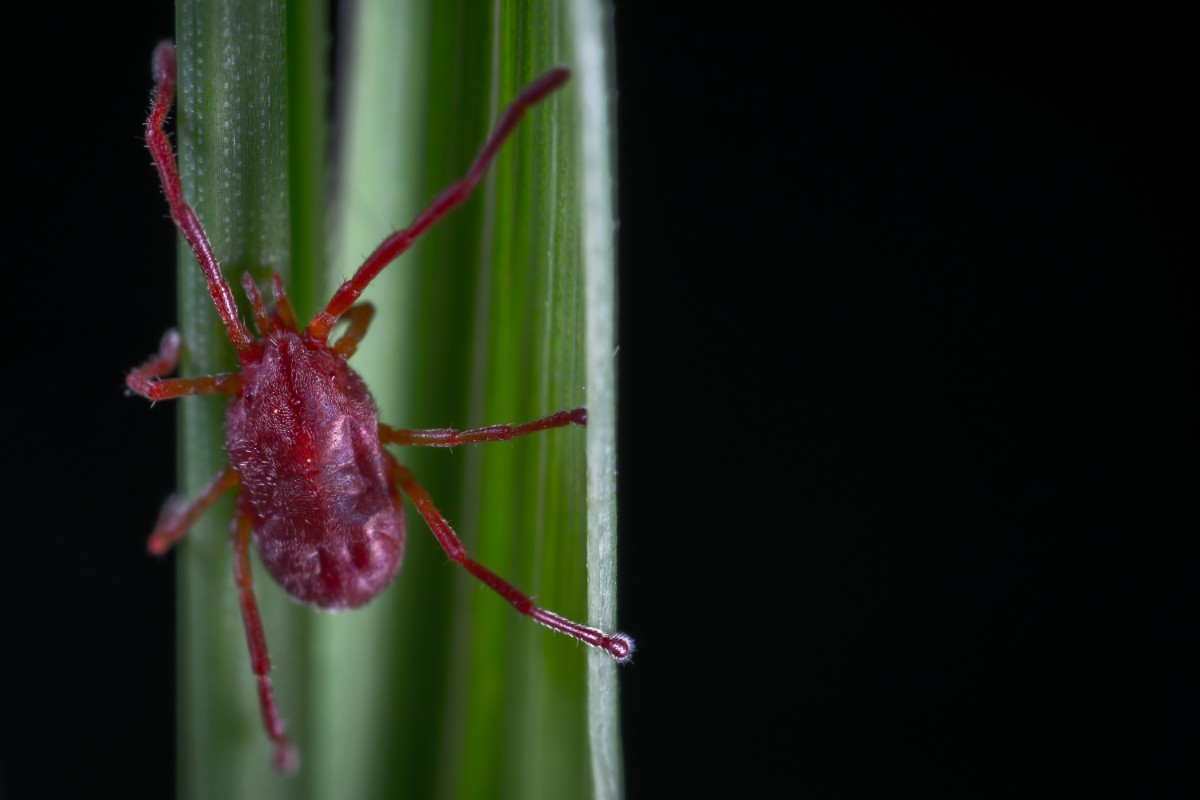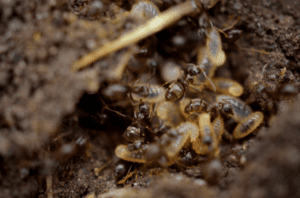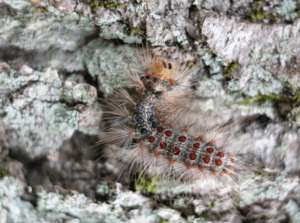

Cooler weather brings plenty of different things. A relief from the summer heat, a chance to cozy up and enjoy a cup of hot chocolate and an influx of fall-loving bugs making an appearance. Clover mites are one of these fall-loving bugs and if you’re in New Jersey you may well have noticed these scarlet-colored clover mites in your yard or even your home.
Curious about clover mites and want to know more?
Our guide answers all your questions about the identification and prevention of clover mites as these bugs can be a nuisance in and around your home.
How To Identify Clover Mites
These tiny mites are arachnids and can be found both inside and outside. They are closely related to ticks, but like spiders, they have 8 legs. Their front legs, which are longer than the other six, are often mistaken for antennae or feelers. Clover mites are really tiny and are slightly smaller than a pinhead, varying in size from 0,75 mm to 0,85 mm. They have oval-shaped bodies, and their abdomens are covered in feathery plates or scales. Their color ranges from a scarlet red to reddish brown. Their larvae can range from pink to salmon or even a bright red color and they go through two nymph stages. These are called protonymph and deutonymph and they have eight legs like the adults. To the naked eye, clover mites resemble dark red little spots. They gather in large groups and can be found around siding, walls, windows, and doors, and even on curtaining or furniture. Their natural red pigment does come off and often stains curtains and furniture, which can be alarming if you don’t know what is causing the stains. Balaustium mites and clover mites are often mistaken for each other as a result of their similar colors. These mites are so tiny that a 20x magnification hand lens is needed to tell the difference between them. While clover mites don’t bite, Balaustium mites do, resulting in a rash.How Do Clover Mites Reproduce?
The larvae of clover mites hatch from unfertilized eggs, so they are parthenogenetic. This means that there are only female clover mites and that no males are needed for reproduction. Clover mites lay around 70 round eggs at a time and the eggs are bright red in color. When hatching, disc-shaped larvae with six legs emerge and every clover mite is genetically identical to the mother. Clover mites lay eggs at two different times of the year in the US. Towards the end of fall, adults will lay overwintering eggs which will hatch in April. The mites then remain active until June. When daily temperatures exceed 85°F, then adults will lay over-summering eggs that will only hatch once the cooler months arrive. When they appear outdoors, a single generation of clover mites live for around a month, with two of those weeks as adults. But left to their own devices, small clover mite problems can turn into a large population very quickly due to their short life span and the number of eggs they lay. If clover mites are inside a home or building, they will die after a few days from dehydration. Fortunately, they do not usually reproduce inside.Clover Mites Active Period
Clover mites cannot survive temperatures higher than 102°F. Any temperatures lower than 75°F induces dormancy in eggs. Their peak active periods are the fall and spring months, and they tend towards inactivity in the summer and winter. Clover mites require very moderate temperatures. When weather conditions become too hot or unbearably cold, these mites will migrate to find either warmer or cooler conditions. They usually lay their eggs around the end of fall and the eggs stay dormant through winter. They hatch in spring. The new hatchlings mature and reproduce until summer arrives. Typically, clover mites become dormant in dry and hot periods (in summer) and reactivate around fall. In the cooler northern-eastern regions, they become dormant from May to September. If the summers are cool enough, clover mites will remain active. To sum up, in New Jersey, clover mites are most likely to invade your home or garden in spring and fall.Are Clover Mites Dangerous?
Luckily clover mites do not cause any health issues, and unlike some other mites, they don’t feed on blood either. Neither do they infest areas or stored products. When crushed, the resulting red stain is the only damage they cause to carpets, furniture, and curtains. Clover mites do however cause extensive damage to gardens, plants, and lawns. The damage to lawns appears as brown spots, and the larger the population, the more extensive the damage. Sometimes entire lawns can die off and this is often mistaken for winter kill. Feeding damage from clover mites on leaves and flowers resembles irregular silvery trails, much like a snail trail. Plants and flowers that are severely damaged will turn brown or yellow and wilt.Where Do Clover Mites Live?
Clover mites live all over the US and occur virtually all over the world. Their eggs are laid in dry areas with enough sun to warm their eggs and the right amount of shade to protect them from high heat. They favor cracks and crevices in exterior walls to lay their eggs. They grow downwards in their eggs, which means they are geotropic. As a result, they drop downwards after hatching. The site of their eggs is usually above a plant to facilitate immediate feeding once they hatch. Adult clover mites are usually found on their food source. They also mass on the sides of sunny walls. If clover mites do migrate indoors, they usually stick to warmer, sunny areas when it is cool, or they seek shady areas when it’s hot. Like many insects, clover mites are attracted to moisture. So, if you find them inside your home, it’s usually an indication there are moisture issues. Check for rotting wood structures on the outside of your home to keep the critters from getting in.Why Do I Have A Clover Mite Problem?
Clover mites can be a problem for many reasons. They have favorite foods such as grasses and certain plants. They particularly like heavily fertilized and lush lawns. They also like plants such as clover, strawberries, primrose, dandelions, shepherd’s purse, daffodils, alyssum, and some ornamental flowers. Some weather conditions, such as heavy rain, can cause clover mites to move indoors. While they need some moisture, they cannot survive in a large amount of water. They like moderate temperatures and will migrate to other areas to escape excessive heat or cold. This means they often find the best temperature inside your home. During spring, their favorite food sources start growing. If these plants are near to your home, then springtime invasions can occur. If their food sources are moved indoors in the fall, then they could invade indoors too.Preventing A Clover Mite Infestation
Prevention is essential with clover mites. Here are some professional tips from the experts at Twin-Boro to prevent an infestation:- Make Your Yard Unattractive To Clover Mites
- Create Barriers Or Perimeters
- Repair Gaps And Cracks






